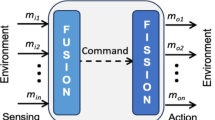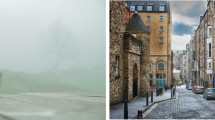Abstract
A psychoacoustic auditory display for navigation is presented. Interactive sonification guides users to an invisible target location in two-dimensional space. Orthogonal spatial dimensions are mapped to perceptual auditory qualities that are orthogonal as well. The psychoacoustic auditory display could serve as an alternative or complement to conventional assistance systems for vehicle or airplane control, or for minimally invasive surgery. The approach is evaluated by an experiment, which compares the performance of 18 participants approaching (i) a visually presented target (ii) an invisible target guided by sound. Results demonstrate that users are able to integrate the sonified information to find the right angle and distance, or to segregate both spatial axes and interpret one at a time. Auditory navigation takes significantly longer than visual navigation, but path lengths are not significantly different.









Similar content being viewed by others
Notes
Visit https://tinyurl.com/ycwmdh8r.
References
Anderson J, Sanderson P (2004) Designing sonification for effective attentional control in complex work domains. In: Proceedings of the human factors and ergonomins society 48th annual meeting, New Orleans, LA. https://doi.org/10.1037/e577082012-006
Aures W (1985) Berechnungsverfahren für den sensorischen Wohlklang beliebiger Schallsignale (A model for calculating the sensory euphony of various sounds). Acustica 59(2):130–141
Bader R (2013) Nonlinearities and synchronization in musical acoustics and music psychology. Springer, Berlin. https://doi.org/10.1007/978-3-642-36098-5
Barrass S (2005) A perceptual framework for the auditory display of scientific data. ACM Trans Appl Percept 2(4):389–402. https://doi.org/10.1145/1101530.1101532
Beauchamp JW (1982) Synthesis by spectral amplitude and ”brightness” matching of analyzed musical instrument tones. J Audio Eng Soc 30(6):396–406
Black D, Hettig J, Luz M, Hansen C, Kikinis R, Hahn H (2017) Auditory feedback to support image-guided medical needle placement. Int J Comput Assist Radiol Surg 12:1655–1663. https://doi.org/10.1007/s11548-017-1537-1
Black D, Issawi JA, Hansen C, Rieder C, Hahn H (2013) Auditory support for navigated radiofrequency ablation. In: Freysinger W (ed) CURAC—12. Jahrestagung der Deutschen Gesellschaft für Computer-und Roboter Assistierte Chirurgie. Innsbruck, pp 30–33. https://www.curac.org/images/advportfoliopro/images/CURAC2013/Proceedings%20CURAC%202013.pdf. Accessed 23 Nov 2018
Bregman AS (1990) Auditory scene analysis. MIT Press, Massachusetts
Brungart DS, Simpson BD (2008) Design, validation, and in-flight evaluation of an auditory attitude indicator based on pilot-selected music. In: Proceedings of the 14th international conference on auditory display (ICAD2008), Paris. http://hdl.handle.net/1853/49897
Belz SM, Robinson GS, Casali JG (1999) A new class of auditory warning signals for complex systems: auditory icons. Hum Factors 41(4):608–618
Cho B, Oka M, Matsumoto N, Ouchida R, Hong J, Hashizume M (2013) Warning navigation system using real-time safe region monitoring for otologic surgery. Int J Comput Assist Radiol Surg 8(3):395–405. https://doi.org/10.1007/s11548-012-0797-z
Dale R, Kehoe C, Spivey MJ (2007) Graded motor responses in the time course of categorizing atypical exemplars. Mem Cognit 35(1):15–28. https://doi.org/10.3758/BF03195938
Daniel P, Weber R (1997) Psychoacoustical roughness: implementation of an optimized model. Acta Acust United Acust 83(1):113–123
Ferguson S, Cabrera D, Beilharz K, Song HJ (2006) Using psychoacoustical models for information sonification. In: Proceedings of the 12th international conference on auditory display (ICAD2006), London. http://hdl.handle.net/1853/50694. Accessed 23 Nov 2018
Florez L (1936) True blind flight. J Aeronaut Sci 3(5):168–170. https://doi.org/10.2514/8.176
Freeman JB, Ambady N (2010) Mousetracker: software for studying real-time mental processing using a computer mouse-tracking method. Behav Res Methods 42(1):226–241. https://doi.org/10.3758/BRM.42.1.226
Hansen C, Black D, Lange C, Rieber F, Lamadé W, Donati M, Oldhafer KJ, Hahn HK (2013) Auditory support for resection guidance in navigated liver surgery. Int J Med Robot Comput Assist Surg 9(1):36–43. https://doi.org/10.1002/rcs.1466
Hart SG, Staveland LE (1988) Development of nasa-tlx (task load index): results of empirical and theoretical research. In: Hancock PA, Meshkati N (eds) Human mental workload. North Holland Press, Amsterdam
Hellier EJ, Edworthy J, Dennis I (1993) Improving auditory warning design: quantifying and predicting the effects of different warning parameters on perceived urgency. Hum Factors 35(4):693–706
Jacobson D (2012) Lloyd relaxation of voronoi diagrams. Wolfram Demonstrations Project http://demonstrations.wolfram.com/LloydRelaxationOfVoronoiDiagrams/. Accessed 23 Nov 2018
Kuppanda T, Degara N, Worrall D, Thoshkahna B, Müller M (2015) Virtual reality platform for sonification evaluation. In: Proceedings of the 21st international conference on auditory display (ICAD2015). Graz, pp 117–124. http://hdl.handle.net/1853/54116. Accessed 23 Nov 2018
Lawson BD (2014) Tactile displays for cueing self-motion and looming: what would Gibson think? In: Stanney K, Hale KS (eds) 5th international conference on applied human factors and ergonomics, pp 3–13
Leman M (2000) Visualization and calculation of the roughness of acoustical musical signals using the synchronization index model (sim). In: Proceedings of the COST G-6 conference on digital audio effects (DAFX-00), Verona
Levinson SC (2003) Space in language and cognition. Cambridge University Press, Cambridge. https://doi.org/10.1017/CBO9780511613609
Lundkvist A, Johnsson R, Nykänen A, Stridfelt J (2017) 3d auditory displays for parking assistance systems. SAE Int J Passeng Cars Electron Electr Syst 10:17–23. https://doi.org/10.4271/2017-01-9627
Lundkvist A, Nykänen A, Johnsson R (2011) 3d-sound in car compartments based on loudspeaker reproduction using crosstalk cancellation. In: 130th audio engineering society convention, London. http://www.aes.org/e-lib/browse.cfm?elib=15802. Accessed 23 Nov 2018
Meyer J (2009) Acoustics and the performance of music. Manual for scousticians audio engineers, musicians, architects and musical instrument makers, 5th edn. Springer, Bergkirchen. https://doi.org/10.1007/978-0-387-09517-2
Nagel F, Stöter FR, Degara N, Balke S, Worrall D (2014) Fast and accurate guidance: response times to navigational sounds. In: Proceedings of the 20th international conference on auditory display (ICAD2014). New York, NY. http://hdl.handle.net/1853/52058. Accessed 23 Nov 2018
Parseihian G, Gondre C, Aramaki M, Ystad S, Kronland-Martinet R (2016) Comparison and evaluation of sonification strategies for guidance tasks. IEEE Trans Multimed 18(4):674–686. https://doi.org/10.1109/TMM.2016.2531978
Perrin DP, Vasilyev NV, Novotny P, Stoll J, Howe RD, Dupont PE, Salgo IS, del Nido PJ (2009) Image guided surgical interventions. Curr Probl Surg 46(9):730–766. https://doi.org/10.1067/j.cpsurg.2009.04.001
Sanderson PM, Watson MO, Russell WJ (2005) Advanced patient monitoring displays: tools for continuous informing. Anesth Analg 101(1):161–168. https://doi.org/10.1213/01.ANE.0000154080.67496.AE
Scheminzky F (1943) Die Welt des Schalls. Das Bergland-Buch, Salzburg
Shepard RN (1964) Circularity in judgments of relative pitch. J Acoust Soc Am 36(12):2346–2353. https://doi.org/10.1121/1.1919362
Strauß G, Schaller S, Zaminer B, Heininger S, Hofer M, Manzey D, Meixensberger J, Dietz A, Lüth T (2011) Klinische erfahrungen mit einem kollisionswarnsystem. HNO 59(5):470–479. https://doi.org/10.1007/s00106-010-2237-0
Wegner K (1998) Surgical navigation system and method using audio feedback. In: ICAD, Glasgow. https://smartech.gatech.edu/handle/1853/50733. Accessed 23 Nov 2018
Ziemer T, Black D (2017) Psychoacoustically motivated sonification for surgeons. Int J Comput Assist Radiol Surg 12:265–266. https://doi.org/10.1007/s11548-017-1588-3
Ziemer T, Black D, Schultheis H (2017) Psychoacoustic sonification design for navigation in surgical interventions. https://doi.org/10.1121/2.0000557
Ziemer T, Schultheis H (2018) A psychoacoustic auditory display for navigation. In: Proceedings of the 24th international conference on auditory display (ICAD2018). Houghton, MI. https://doi.org/10.21785/icad2018.007
Ziemer T, Schultheis H, Black D, Kikinis R (2018) Psychoacoustical interactive sonification for short range navigation. Acta Acust United Acust 104(6):1075–1093. https://doi.org/10.3813/AAA.919273
Zwicker E, Fastl H (1999) Psychoacoustics. Facts and models, 2nd edn. Springer, Berlin. https://doi.org/10.1007/978-3-662-09562-1
Author information
Authors and Affiliations
Corresponding author
Additional information
Publisher's Note
Springer Nature remains neutral with regard to jurisdictional claims in published maps and institutional affiliations.
Rights and permissions
About this article
Cite this article
Ziemer, T., Schultheis, H. Psychoacoustic auditory display for navigation: an auditory assistance system for spatial orientation tasks. J Multimodal User Interfaces 13, 205–218 (2019). https://doi.org/10.1007/s12193-018-0282-2
Received:
Accepted:
Published:
Issue Date:
DOI: https://doi.org/10.1007/s12193-018-0282-2




